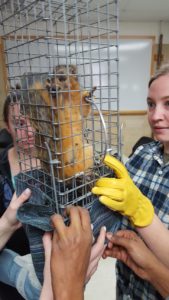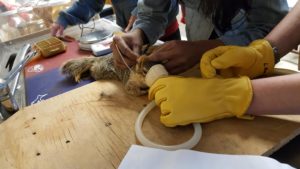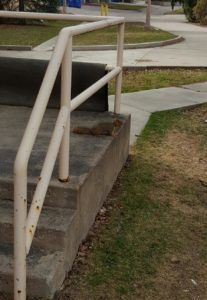Have you ever noticed that some squirrels on campus look a little nutty? Perhaps some are wearing a necklace?
The Warner College of Natural Resources teaches a class called “Wildlife Data Collection and Analysis” that actually allows students to put collars on CSU squirrels to collect data. The course is a capstone for students majoring in Fish, Wildlife and Conservation Biology.
The class is taught every spring and fall, and the students collar a total of four squirrels each semester.
“This experience gives students the opportunity to handle a live mammal,” said Larissa Bailey, an associate professor who teaches the course in the Department of Fish, Wildlife and Conservation Biology. “Having that contact with a live animal is something that our students do not get to have all the time.”
The students in the course trap and anesthetize the squirrel before attaching the collar. After that the students release the squirrel, and throughout the remainder of the semester, the students relocate the squirrels to different locations.
The resulting data is used to estimate each squirrel’s home range. Home range is basically the size of the area that the squirrels used over the four-month period during the semester. This helps the students learn where the squirrels go, where they spend their time, and how often they visit certain areas on campus.
The small collars used on the squirrels have a transmitter and a receiver for collecting data.
 The process
The process
Catching a squirrel is not always an easy task, and sometimes the weather or the season can make all the difference. The best times to catch them are after a storm when they are especially hungry, or other times when the squirrels don’t have many resources. Students typically catch the squirrels in early fall and late spring, because of the mild conditions for the students and the squirrels.
 When the students in the course are divided into groups, they are given a trap. The trapping usually takes place on a Saturday morning, to avoid disturbing campus activities. Students bait the traps with apples and peanut butter, and more often than not are able to catch the targeted squirrel.
When the students in the course are divided into groups, they are given a trap. The trapping usually takes place on a Saturday morning, to avoid disturbing campus activities. Students bait the traps with apples and peanut butter, and more often than not are able to catch the targeted squirrel.
The students anesthetize the squirrels, record the squirrel’s sex and weight, put on the collars and then release them back on campus. The capturing and collaring provide excellent real-life experience to the CSU students, and the Warner College looks to the squirrels for many different research opportunities.
“In this same course, we have a field lab where you go out and take observations of squirrels in different places on campus,” said Bailey. “Through those observations, we can estimate the distribution of squirrels on campus and explore what factors influence why the squirrels chose a specific spot.
“We use squirrels for many of our labs in that course.”
The CSU students and faculty are careful not to harm the squirrels, and they have the required permits from both Colorado Parks and Wildlife and the University’s Animal Care and Use Committee.